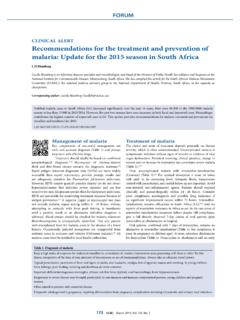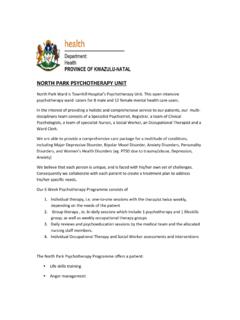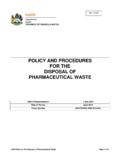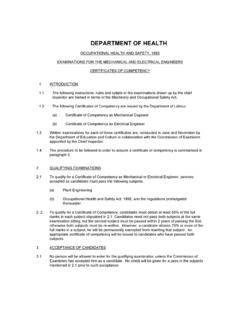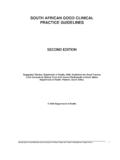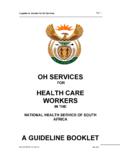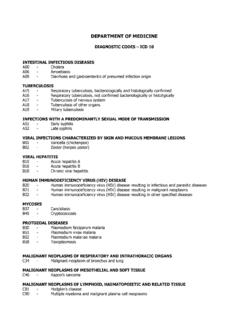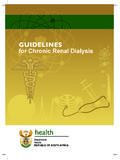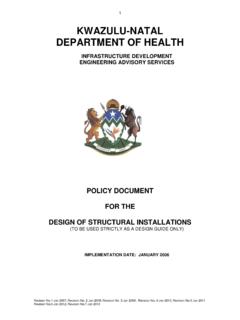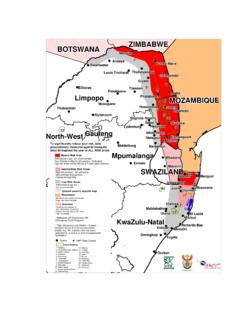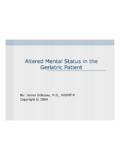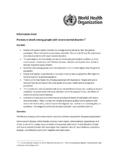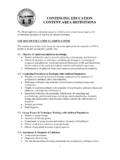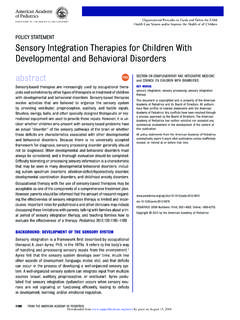Transcription of Treatment Protocols for Mental Disorders
1 KwaZulu-Natal Treatment Protocols for Mental Health Disorders 1 INTRODUCTION These KZN Treatment Protocols for Mental Disorders have been developed in response to a need for practical guidelines to managing common psychiatric Disorders at District and Community level. With this in mind, the editors and contributors have ensured that the Protocols are based on the Standard Treatment Guidelines and Essential Drug List (2006) issued by the Department of Health. Thus all medications named in the Protocols are available at District and Community level health facilities in KwaZulu-Natal. Furthermore, these Protocols are aimed at non-psychiatrist clinicians ( Medical Officers and Psychiatric Nurses) who are involved in the day to day management of Mental health care users. Finally, we have elected to produce Protocols that are based on common clinical presentations ( psychosis, aggression, insomnia) rather than on specific psychiatric Disorders ( schizophrenia).
2 The Treatment Protocols are a result of collaboration between the KZN Provincial Directorate for Mental Health, the Psychiatry Department at the University of KwaZulu-Natal and Eli Lilly Pharmaceuticals. The Protocols were written and edited by members of staff in the UKZN Department of Psychiatry. We are grateful to these individuals for their efforts. We also thank Eli Lilly for their sponsorship of both this booklet and a number of workshops held throughout the Province to present these Protocols . Finally we thank the KZN Provincial Department of Health for their support for this project. Dr Jonathan Burns Dr Howard King Dr Shamima Saloojee Department of Psychiatry NRMSM UKZN April 2007 CONTRIBUTORS Dr J Burns Dr U Chhagan Dr K Jhazbhay Dr Z Kader Dr E Karim Dr H King Dr S Mashapu Prof D Mkize Dr J Naidoo Dr K Narsi Dr S Paruk Dr S Ramlall Dr N Raymond Dr S Saloojee 2 3 CONTENTS 1.
3 GUIDELINES FOR THE ADMISSION OF INVOLUNTARY AND ASSISTED PERSONS UNDER THE Mental HEALTH CARE ACT, 2002 (ACT NO. 17 0F 2002) 2. MANAGEMENT OF AGGRESSIVE, VIOLENT PATIENTS 3. MANAGEMENT OF THE SUICIDAL PATIENT 4. AN APPROACH TO PSYCHOSIS AND THE USE OF ANTIPSYCHOTICS 5. AN APPROACH TO MOOD Disorders AND THEIR Treatment 6. AN APPROACH TO ANXIETY Disorders AND THEIR Treatment 7. MANAGING SUBSTANCE AND ALCOHOL PROBLEMS 8. THE MANAGEMENT OF DELIRIUM 9. BEHAVIOURAL PROBLEMS IN THE ELDERLY 10. DISRUPTIVE BEHAVIOUR PROBLEMS IN CHILDREN AND ADOLESCENTS 11. BEDWETTING 12. POOR SCHOOL PERFORMANCE 13. THE MANAGEMENT OF INSOMNIA 14. FORENSIC PSYCHIATRY ISSUES 4 GUIDELINES FOR THE ADMISSION OF INVOLUNTARY AND ASSISTED PERSONS UNDER THE Mental HEALTH CARE ACT, 2002 (ACT NO. 17 0F 2002) STEP 1 Friends /family to complete Application for admission on form 04.
4 STEP 2 Person to be assessed by 2 Mental health care practitioners (MHCP) and examination and findings to be recorded on form 05. STEP 3 MHCP must submit forms 04 and 05 to Head of Health Establishment (HHE). STEP 4 HHE to decide on whether or not to provide further care and to give notice of consent to such care on form 07. STEP 5 Person can now be admitted /treated for 72 hrs without his/her consent. STEP 6 Person to be assessed every 24 hours for 72 hours. STEP 7 2 MHCP re- assess person after 72 hours have elapsed and examination and findings recorded on form 06. STEP 8 MHCP submit form 06 to HHE. STEP 9 HHE decides whether person needs to be further treated as an outpatient (09), inpatient (08), or to be discharged (03) and gives notice to Review Board of same on forms depicted in parenthesis above. STEP 10 If further Treatment is required as an inpatient person must be transferred to a Psychiatric Hospital.
5 HHE to complete form 11. 5 ALGORITHM FOR THE ADMISSION OF INVOLUNTARY/ ASSISTED PERSONS UNDER MHCA STEP 1 APPLICATION FORM 04 STEP 2 ASSESSMENT FORMS 05 STEP 3 SUBMIT 04 AND 05 TO HHE STEP 4 HHE CONSENT FORM 07 STEP 5 72 HOUR ADMISSION STEP 6 ASSESSMENT EVERY 24 HOURS STEP 7 POST 72 HR ASSESSMENT FORMS 06 STEP 8 SUBMIT FORM 06 TO HHE STEP 9 HHE TO DECIDE: DISCHARGE O3 OUTPATIENT 09 INPATIENT O8 STEP 10 TRANSFER TO PSYCHIATRIC HOSPITAL 11 6 MANAGEMENT OF AGGRESSIVE, VIOLENT PATIENTS DEFINITIONS Aggression is any form of behaviour directed towards the goal of harming or injuring another living being who is motivated to avoid such Treatment . Violence is harmful behaviour inflicted upon another person or property involving the use of force. Violence is defined as the act that leads to physical harm or destruction.
6 Aggression may or may not result in violence but all violence is aggression. Phases of dealing with aggression or violence: Phase 1: De-escalation Phase 2: Physical restraint Phase 3: Sedation Phase 4: Mechanical restraint Phase 5: Post sedation / Seclusion / Transfer Phase 1: De-escalation De-escalation is a process to defuse a potentially violent or aggressive situation without having to resort to physical restraint. During physical restraint there is a risk of injury to both the patient and the staff, therefore there is a need for verbal intervention, which could help to reduce the threat of violence and return the patient to a calm state of mind. - Show concern or empathy - Speak quietly but clearly and calmly; don t argue - Assist patient to stay in control - Set limits firmly but do not threaten - Allow extra personal space - Deal with the issue at hand - Ensure safe environment and remove all potential weapons (alert SAPS if patient has dangerous weapons on hand) - Ensure safe exit point for staff - Encourage patient to talk and make use of appropriate listening skills - Offer medication to patient.
7 Initially oral therapy - Allow patient to find a solution to the problem Phase 2: Physical Restraint - Team leader to co-ordinate - Evacuation of staff and patients not involved - Obtain assistance of at least 4 other staff members - Inform the patient that the intention is to restrain and sedate - Each person should hold a limb and the team leader should hold the patient s head while talking to the patient 7 Phase 3: Sedation (See flow chart) - Initially offer patient oral therapy - If patient refuses and de-escalation techniques have failed, use intramuscular or intravascular therapy - Lorazepam (Ativan) 2mg 4mg IMI/IVI stat give slowly over 3 minutes after diluting - Do not risk needlestick injury if IV is difficult - If patient not sedated after 20 minutes, administer Haloperidol 5mg IMI stat which may be repeated using 5mg every hour to a maximum of 20mg - Obtain collateral information from family members or those accompanying the patient Phase 4.
8 Mechanical Restraint - Not to be used as a punitive measure, but for the safety of the patient and others, until sedation takes effect - Not to be used for longer than 30 minutes at a time according to the Mental Health Care Act regulations - Form MHCA 48 to be completed and presented to the Hospital Manager daily and to the Mental Health Review Board quarterly - Restrain in a semi-prone position ensuring that the limbs are not contorted, to prevent aspiration and compression injury Phase 5: Post Sedation/Seclusion/Transfer - Assign a staff member to be with patient until he/she becomes ambulant or until transfer effected - Patient to be preferably nursed in a seclusion room - Once sedated or calm, to attempt history taking, physical Mental state examination and special investigations (esp. blood glucose) to evaluate cause of behavioural disturbance - Blood pressure, pulse rate and respiration to be monitored every 5 10 minutes in first hour and then every 15 minutes until ambulant - If BP drops below 100/60, elevate lower limbs of patient - If BP does not respond, IV fluids need to be commenced - Document all nursing care and medication accurately - If secluded, form MHCA 48 needs to be filed and presented to the Hospital Manager daily and the Mental Health Review Board quarterly - Transfer of patient to a psychiatric hospital should occur after 72 hours assessment at District Hospital or as an emergency before 72 hours after necessary arrangements being made 8 9 GUIDELINES FOR THE RAPID TRANQUILLISATION OF AGGRESSIVE, VIOLENT PATIENTS INITIAL CONSIDERATIONS 1.
9 DE-ESCALATION Talking down, time out, distraction, privacy and quiet. 2. MEDICATIONS Note any Psychotropic medication received in last few hours. 3. ADVANCE DIRECTIVES Patient preferred Treatment choices. OFFER ORAL THERAPY CHLORPROMAZINE (LARGACTIL) (Max 300mg /24hrs) 25 75mg initially (Sedation in 30 minutes, peaks in 1 3 hours, lasts 3 4 hours) Take special note of contraindications for use epilepsy, elderly, alcohol abuse, liver disease, CVS disease, coma or CNS depression, etc. OR HALOPERIDOL (SERENACE) 5 10mg (Max 30mg/24hrs) not for the neuroleptic na ve Review temperature, pulse, blood pressure and respiratory rate every 5 10 minutes for one hour and then hourly until patient is ambulatory. INTRAMUSCULAR THERAPY LORAZEPAM (ATIVAN) 2 4 mg IMI (Max 6mg/24hrs) Sedation in 30 45 minutes; peaks in 1 3 hours, lasts 4 6 hours + / - HALOPERIDOL (SERENACE) 5mg IMI (Max 18mg / 24hrs) Sedation in 10 minutes; peaks in 20 minutes OR OLANZAPINE (ZYPREXA) 5 10mg IMI (Max 20mg/24 hrs) 2 hour interval between injections; peaks 15 45 minutes OR CLOTHIAPINE (ETOMINE) (max 360mg/24 hrs) Initial dose 40 80mg and repeated 2 3 times per day [DO NOT MIX INJECTIONS IN ONE SYRINGE] Review half hourly and repeat as necessary up to maximum dose.
10 Monitor respiratory rate and give Flumazenil if rate falls below 10 per minute IF NO IMPROVEMENT, REVIEW AND CONSULT SENIOR COLLEAGUE NB: For elderly patients, halve doses and titrate according to response Consider DIAZEPAM (VALIUM) 10mg 1V Ensure Flumazenil available Monitor vital signs, especially respiration throughout Oxygen and airway must be availableConsider CLOPIXOL ACUPHASE IM 50 150mg (Sedation in 1 2 hrs, peaks in 36 hours, lasts 72 hours) ONLY IF Patient is detained under Mental Health Act ANDisnot antipsychotic na ve. 10 MANAGEMENT OF THE SUICIDAL PATIENT EPIDEMIOLOGY Increase during the 20th Century Rates: 25/100000 (N. Europe) 10/100000 (S. Europe) Two peaks: 15-24 years and over 45years 3rd cause of death in adolescents (12%) - steadily increasing! Completed suicide: male: female 3:1 Attempted suicide: male: female 1:4 RISK FACTORS FOR SUICIDE o Male o Elderly o Single, divorced, widowed o Living alone, poor social support o Unemployed o low socioeconomic status o Previous suicide attempt or self-harm o Any Mental disorder o Alcohol/ drug abuse/dependence o Recent in-patient Psych Rxn o Concurrent physical disorder o Recent bereavement ASSESSMENT MANAGEMENT 1.
